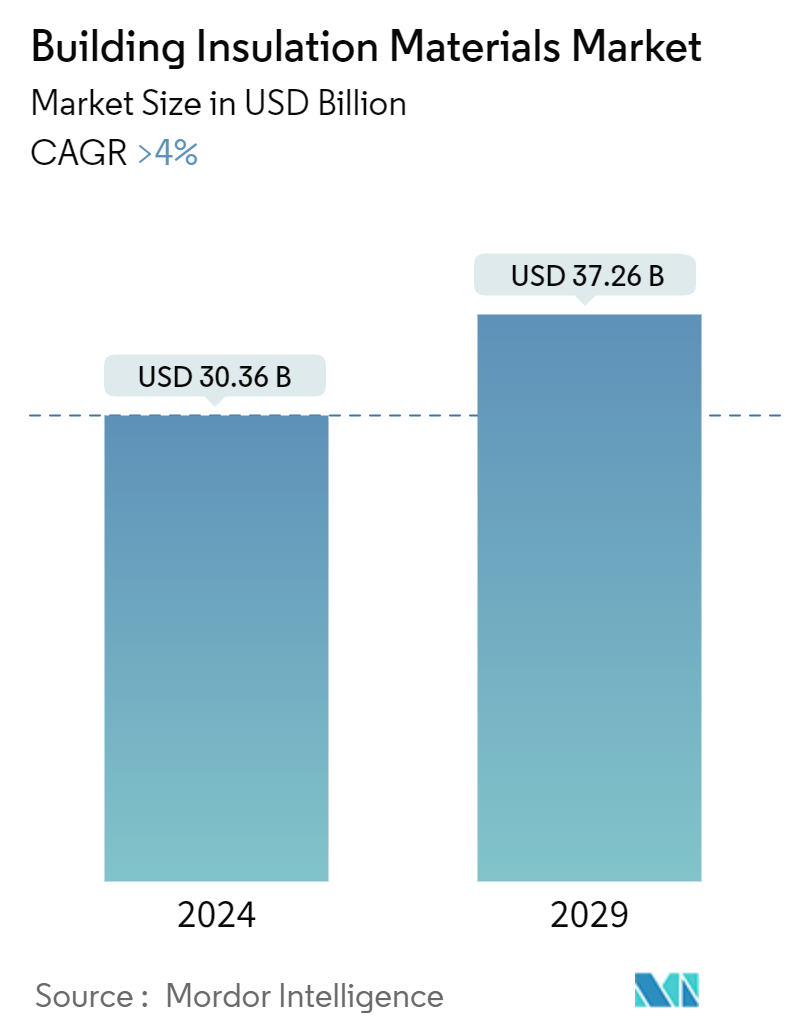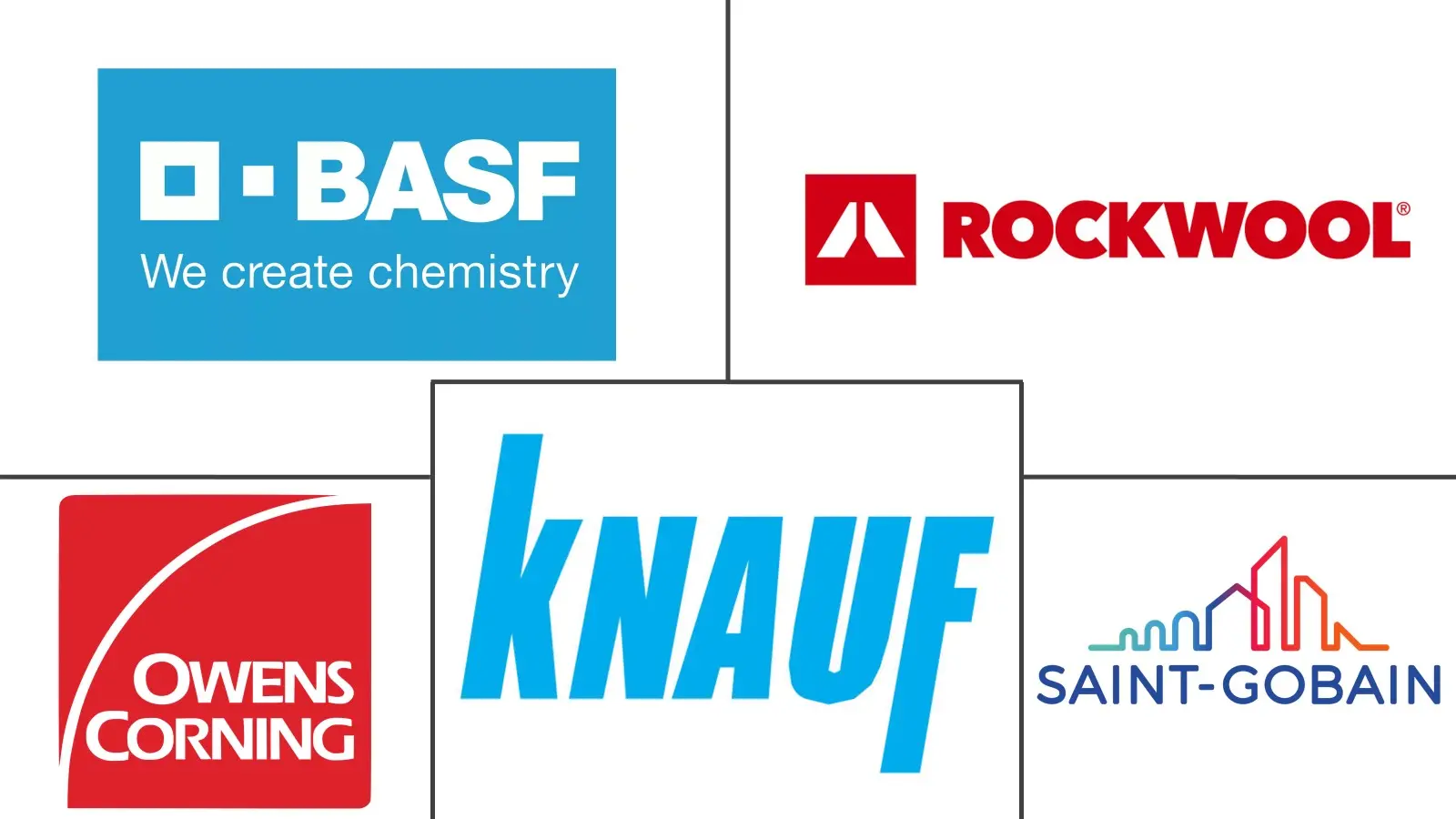Market Size of Building Insulation Materials Industry

| Study Period | 2019 - 2029 |
| Market Size (2024) | USD 30.36 Billion |
| Market Size (2029) | USD 37.26 Billion |
| CAGR (2024 - 2029) | > 4.00 % |
| Fastest Growing Market | Asia Pacific |
| Largest Market | Europe |
| Market Concentration | Low |
Major Players
*Disclaimer: Major Players sorted in no particular order |
Building Insulation Materials Market Analysis
The Building Insulation Materials Market size is estimated at USD 30.36 billion in 2024, and is expected to reach USD 37.26 billion by 2029, growing at a CAGR of greater than 4% during the forecast period (2024-2029).
Due to the impact of COVID-19 in 2020, the production facilities were halted for several months as lockdowns were implemented, and the supply chains were splintered. However, the market recovered from 2021 to 2022, owing to rising consumption from end-user industries, especially the residential industry.
- The growing demand for energy efficiency, infrastructure expansion, and industrialization in Asia-Pacific are the main factors anticipated to boost the demand for building insulation materials.
- Harmful effects caused by building insulation materials on exposure to high temperatures are expected to hamper the market's growth.
- The use of organic products for insulation may provide new growth opportunities for the market.
- Europe dominated the building insulation materials market. Asia-Pacific is projected to be the fastest-growing market due to the increasing consumption from countries such as China and India.
Building Insulation Materials Industry Segmentation
Building insulation materials are the building materials that reduce heat transfer and form a thermal envelope for the building. Building insulation materials contribute significantly to reducing energy consumption in buildings and sustain the affordability of the construction industry by improving the cost of energy and performance in the building envelope (walls, roofs, floors, etc.), windows, mechanical systems, as well as on-site renewable generation and thermal systems. Building insulation is a material that prevents heat or sound from being transmitted from one area to another. Building insulation is mainly for thermal and acoustic purposes. However, it is also used for impact resistance and fire insulation.
The building insulation materials market is segmented by type, end-user industry, and geography. The market is segmented by types into fiberglass, mineral wool, cellulose, polyurethane/ polyisocyanurate (PUR/PIR) foam, polystyrene, and other insulation materials (hemp, straw, etc.). By end-user industry, the market is segmented into residential and non-residential. The report also covers the market sizes and forecasts for the building insulation materials market in 27 countries across major regions. For each segment, the market sizing and forecasts are provided in terms of revenue (USD).
| Type | |
| Fiberglass | |
| Mineral Wool | |
| Cellulose | |
| Polyurethane/ Polyisocyanurate (PUR/PIR) Foam | |
| Polystyrene | |
| Other Insulation Materials |
| End-user Industry | |||||
| Residential | |||||
|
| Geography | |||||||||||
| |||||||||||
| |||||||||||
| |||||||||||
| |||||||||||
|
Building Insulation Materials Market Size Summary
The building insulation materials market is poised for growth, driven by increasing demand for energy efficiency and infrastructure expansion, particularly in the Asia-Pacific region. The market, which experienced disruptions due to the COVID-19 pandemic, has shown resilience and is expected to continue its upward trajectory. The residential construction sector is a significant contributor to this growth, with rising urbanization and the trend towards nuclear families fueling demand. Europe remains a dominant player in the market, with a focus on renovation projects aimed at improving energy efficiency and reducing emissions. The European Commission's renovation wave is expected to significantly boost the demand for insulation materials, as countries like Germany and Italy invest in enhancing their building stocks.
Despite the positive outlook, the market faces challenges, such as the potential harmful effects of insulation materials at high temperatures. However, the shift towards organic insulation products presents new opportunities for market expansion. The market is characterized by fragmentation, with key players like Saint-Gobain, Owens Corning, and Rockwool International A/S leading the charge in innovation and product development. Recent launches, such as Kingspan Group's bio-based insulation product and Energystore Limited's low-carbon footprint range, highlight the industry's commitment to sustainability. As the global focus on energy efficiency and sustainable construction intensifies, the building insulation materials market is expected to experience robust growth over the forecast period.
Building Insulation Materials Market Size - Table of Contents
-
1. MARKET DYNAMICS
-
1.1 Drivers
-
1.1.1 Growing Demand for Energy Efficiency
-
1.1.2 Rising Infrastructure and Industrialization in Asia-Pacific
-
-
1.2 Restraints
-
1.2.1 Harmful Effects as a Result of Exposure to Certain High-temperature Insulation Materials
-
-
1.3 Industry Value Chain Analysis
-
1.4 Porter's Five Forces Analysis
-
1.4.1 Bargaining Power of Suppliers
-
1.4.2 Bargaining Power of Buyers
-
1.4.3 Threat of New Entrants
-
1.4.4 Threat of Substitute Products and Services
-
1.4.5 Degree of Competition
-
-
-
2. MARKET SEGMENTATION (Market Size in Value)
-
2.1 Type
-
2.1.1 Fiberglass
-
2.1.2 Mineral Wool
-
2.1.3 Cellulose
-
2.1.4 Polyurethane/ Polyisocyanurate (PUR/PIR) Foam
-
2.1.5 Polystyrene
-
2.1.6 Other Insulation Materials
-
-
2.2 End-user Industry
-
2.2.1 Residential
-
2.2.2 Non-residential
-
2.2.2.1 Commercial
-
2.2.2.2 Infrastructure
-
2.2.2.3 Other Non-residential Industries (Civic, Religious Buildings, etc.)
-
-
-
2.3 Geography
-
2.3.1 Asia-Pacific
-
2.3.1.1 China
-
2.3.1.2 India
-
2.3.1.3 Japan
-
2.3.1.4 South Korea
-
2.3.1.5 Thailand
-
2.3.1.6 Indonesia
-
2.3.1.7 Vietnam
-
2.3.1.8 Malaysia
-
2.3.1.9 Rest of Asia-Pacific
-
-
2.3.2 North America
-
2.3.2.1 United States
-
2.3.2.2 Canada
-
2.3.2.3 Mexico
-
-
2.3.3 Europe
-
2.3.3.1 Germany
-
2.3.3.2 United Kingdom
-
2.3.3.3 Italy
-
2.3.3.4 France
-
2.3.3.5 Spain
-
2.3.3.6 Russia
-
2.3.3.7 NORDIC
-
2.3.3.8 Turkey
-
2.3.3.9 Rest of Europe
-
-
2.3.4 South America
-
2.3.4.1 Brazil
-
2.3.4.2 Argentina
-
2.3.4.3 Colombia
-
2.3.4.4 Rest of South America
-
-
2.3.5 Middle East and Africa
-
2.3.5.1 Saudi Arabia
-
2.3.5.2 South Africa
-
2.3.5.3 Qatar
-
2.3.5.4 Egypt
-
2.3.5.5 United Arab Emirates
-
2.3.5.6 Nigeria
-
2.3.5.7 Rest of Middle East and Africa
-
-
-
Building Insulation Materials Market Size FAQs
How big is the Building Insulation Materials Market?
The Building Insulation Materials Market size is expected to reach USD 30.36 billion in 2024 and grow at a CAGR of greater than 4% to reach USD 37.26 billion by 2029.
What is the current Building Insulation Materials Market size?
In 2024, the Building Insulation Materials Market size is expected to reach USD 30.36 billion.

